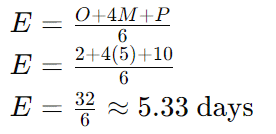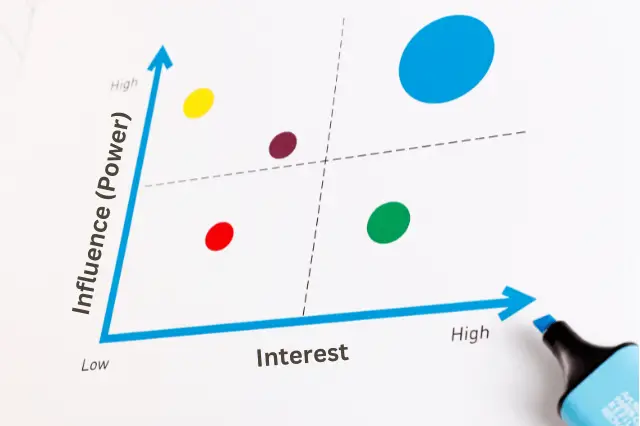Last Updated on September 2, 2024 by andrewshih
Are you struggling with project estimates that seem to miss the mark? Understanding the technique of three-point estimating could revolutionize how you approach project timelines and costs, bringing greater accuracy and confidence to your project management practices.
- What is Three-Point Estimating?
- Three-Point Estimating Formula
- Purpose of Three-Point Estimating
- When to Use Three-Point Estimating
- Three-Point Estimating in Project Management
- Advantages and Disadvantages
- Steps for Three-Point Estimating
- Best Practices
- Mistakes to Avoid
- Three-Point Estimating Example
- Three-Point Estimating Alternatives
- Tools for Three-Point Estimating
- Conclusion
- FAQ
What is Three-Point Estimating?
Three-point estimating is a project management technique that improves the accuracy of time and cost estimates by considering uncertainty and risk. Unlike single-point estimating, which uses a single value, three-point estimating uses three distinct values to estimate an activity’s duration or cost:
- Optimistic (O): The best-case scenario where everything goes better than expected.
- Pessimistic (P): The worst-case scenario considering potential problems and delays.
- Most Likely (M): The most probable outcome based on normal conditions and historical data.
Three-Point Estimating Formula
The formula for three-point estimating is:

Where:
- E is the expected value.
- O is the optimistic estimate.
- M is the most likely estimate.
- P is the pessimistic estimate.
Purpose of Three-Point Estimating
The primary purpose of three-point estimating is to enhance the accuracy of project estimates. By accounting for uncertainty and variability, this technique provides a realistic range of possible outcomes. This approach helps project managers:
- Improve Planning Accuracy: Offers a more comprehensive understanding of potential risks and their impact on project timelines and budgets.
- Manage Risks Effectively: Identifies possible scenarios and prepares contingencies.
- Enhance Stakeholder Communication: Clearly explains the rationale behind estimates, building trust and transparency.
When to Use Three-Point Estimating
Three-point estimating is particularly beneficial in the following scenarios:
- High Uncertainty Projects: Projects with many unknowns or new technologies.
- Lack of Historical Data: Tasks without much previous data to rely on.
- Significant Expert Judgment Variability: When experts have differing opinions on estimates.
- Complex and Critical Tasks: Activities crucial to the project’s success.
Three-Point Estimating in Project Management
Three-point estimating is widely used in project management, particularly in the planning phase. It helps project managers create more accurate and realistic project schedules and budgets by considering a range of outcomes. The technique can be applied to both cost and time estimates, enhancing overall project predictability.
Advantages and Disadvantages
Advantages
-
Improved Accuracy: By considering a range of scenarios, three-point estimating provides a more accurate picture of potential outcomes.
-
Risk Identification: Helps identify and plan for potential risks, improving overall project risk management.
-
Better Communication: Provides clear explanations for estimate ranges, facilitating better communication with stakeholders.
-
Informed Decision Making: Enables project managers to make more informed decisions based on a range of possible outcomes.
Disadvantages
-
Time-Consuming: Requires significant effort to gather data and expert opinions, which can be time-consuming.
-
Complexity: Can be complex to calculate and justify, particularly to stakeholders unfamiliar with the technique.
-
Requires Expert Input: Relies heavily on expert judgment, which can introduce bias if not carefully managed.
Steps for Three-Point Estimating
- Identify the Task: Clearly define the task or activity to be estimated.
- Gather Information: Collect data from past projects and expert opinions.
- Determine the Three Estimates:
- Optimistic (O): Best-case scenario.
- Pessimistic (P): Worst-case scenario.
- Most Likely (M): Most probable outcome.
- Calculate the Expected Value (E): Use the formula to compute the estimate.
- Document Assumptions: Note any assumptions made during the estimation process.
- Review and Refine: Regularly review and update the estimates as more information becomes available.
Best Practices
-
Involve Experts: Engage team members with relevant experience and expertise to provide input on estimates.
-
Use Historical Data: Leverage data from past projects to inform estimates and validate assumptions.
-
Document Everything: Clearly document all assumptions, data sources, and rationale behind the estimates.
-
Regular Updates: Continuously update estimates as new information and data become available.
-
Communicate Clearly: Ensure all stakeholders understand the basis of the estimates and the range of possible outcomes.
Mistakes to Avoid
-
Ignoring Historical Data: Failing to use past project data can lead to inaccurate estimates.
-
Underestimating Variability: Not accounting for potential variations and risks can result in unrealistic plans.
-
Lack of Expert Involvement: Relying solely on one person’s judgment can introduce bias.
-
Poor Documentation: Not documenting assumptions and data sources can lead to misunderstandings and disputes.
Three-Point Estimating Example
Suppose you are estimating the duration of a software development task:
- Optimistic (O): 2 days
- Pessimistic (P): 10 days
- Most Likely (M): 5 days
Using the three-point estimate formula:

Three-Point Estimating Alternatives
- Analogous Estimating: Uses historical data from similar projects to make estimates. Less accurate but faster and simpler.
- Bottom-Up Estimating: Breaks down project work into smaller tasks and estimates each individually. Very detailed but time-consuming.
- Parametric Estimating: Uses statistical relationships between historical data and other variables to calculate an estimate. Effective for repetitive tasks.
Tools for Three-Point Estimating
- Microsoft Project: Offers built-in functionalities for three-point estimating, making it easier to apply this technique within project schedules.
- Primavera P6: Supports detailed risk analysis and three-point estimates, suitable for large and complex projects.
- Smartsheet: Provides templates and tools for three-point estimating, helping teams collaborate effectively.
- ProjectManager.com: Offers robust project management features, including support for three-point estimating.
- Wrike: Includes tools for project planning and estimation, supporting various estimating techniques.
Conclusion
Three-point estimating is a powerful tool that can significantly improve the accuracy and reliability of project estimates.
By considering a range of possible outcomes, project managers can better manage risks, plan more effectively, and communicate more transparently with stakeholders.
While it requires effort and expertise, the benefits of three-point estimating make it a valuable technique for any project manager looking to enhance their project planning processes.
References
- Project Management Institute. (2021). PMBOK® Guide.
- Kerzner, H. (2017). Project Management: A Systems Approach to Planning, Scheduling, and Controlling.
- Larson, E. W., & Gray, C. F. (2020). Project Management: The Managerial Process.
FAQ
How does three-point estimating account for uncertainty?
Three-point estimating incorporates uncertainty by using optimistic, pessimistic, and most likely estimates, which together provide a range that reflects different possible outcomes.
Can three-point estimating be used for both cost and time estimates?
Yes, three-point estimating can be applied to both cost and time estimates, making it a versatile tool in project management.
How do you handle biased estimates in three-point estimating?
To handle biased estimates, involve multiple experts, use historical data, and cross-verify estimates with similar projects.
What role does expert judgment play in three-point estimating?
Expert judgment is crucial in three-point estimating as it provides insights and assessments based on experience, which are essential for determining the optimistic, pessimistic, and most likely estimates.
How do you communicate three-point estimates to stakeholders?
Communicate three-point estimates by explaining the rationale behind the range of values, the method used to derive them, and how they provide a more realistic picture of potential outcomes.
Is three-point estimating suitable for all types of projects?
Three-point estimating is particularly suitable for projects with high uncertainty and variability. However, simpler estimating methods might be sufficient for very straightforward or repetitive tasks.
How frequently should three-point estimates be updated?
Three-point estimates should be updated regularly, especially as new information emerges or significant changes occur in the project scope or environment.
How does three-point estimating integrate with other project management methodologies?
Three-point estimating can be integrated with methodologies like Agile, where it helps in sprint planning and risk management, or with Waterfall, where it aids in creating more accurate project timelines and budgets.
What industries benefit most from three-point estimating?
Industries with high project complexity and uncertainty, such as construction, IT, aerospace, and engineering, benefit significantly from three-point estimating due to its ability to account for risk and variability.
How do you ensure consistency in three-point estimating across multiple projects?
Ensure consistency by developing standard guidelines and templates for three-point estimating, training team members, and regularly reviewing and refining the estimation process.
What is the relationship between three-point estimating and Monte Carlo simulation?
Three-point estimating provides input values for Monte Carlo simulation, which then uses these values to generate a range of possible outcomes and probabilities, enhancing risk analysis and decision-making.



